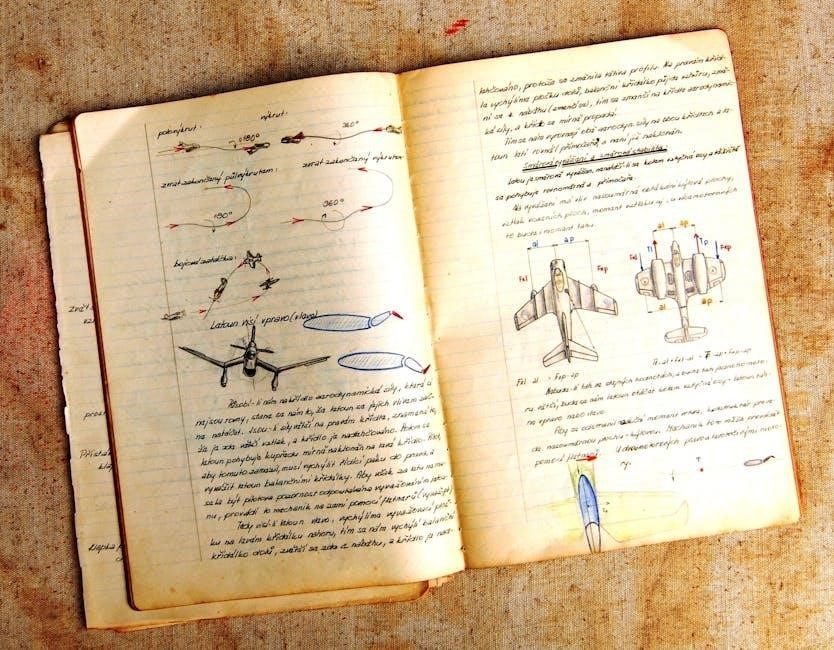The AnyTone AT-778UV is a dual-band VHF/UHF mobile radio designed for amateur communication․ It supports APRS and offers high-power output‚ making it versatile for various applications․ Popular among ham radio enthusiasts‚ it combines reliability with advanced features for seamless communication experiences․
1․1 Overview of the AnyTone AT-778UV
The AnyTone AT-778UV is a dual-band VHF/UHF mobile transceiver designed for amateur radio communication․ It features a compact design‚ robust build quality‚ and advanced capabilities like APRS support․ With high-power output options‚ it ensures reliable long-range communication․ Popular among ham radio enthusiasts‚ the AT-778UV offers a user-friendly interface‚ making it accessible to both newcomers and experienced operators․ Its versatility and durability make it a top choice for various communication needs․
1․2 Importance of the Manual for Users
The manual is essential for understanding the AnyTone AT-778UV’s features‚ operation‚ and maintenance․ It provides detailed guidance for setup‚ programming‚ and troubleshooting‚ ensuring users can fully utilize the radio’s capabilities․ Without the manual‚ users may miss critical settings or safety precautions‚ potentially leading to suboptimal performance or damage; It serves as a comprehensive reference‚ helping users maximize their communication experience and troubleshoot common issues efficiently․

Key Features of the AnyTone AT-778UV
The AnyTone AT-778UV offers dual-band VHF/UHF operation‚ built-in TNC for APRS‚ and high-power output‚ making it a versatile and powerful choice for amateur radio communication needs․
2․1 Dual-Band VHF/UHF Capability
The AnyTone AT-778UV operates on both VHF (136-174 MHz) and UHF (400-470 MHz) frequencies‚ providing flexible communication options․ This dual-band functionality allows users to switch seamlessly between bands‚ ensuring compatibility with a wide range of amateur radio systems․ The radio’s robust design and reliable performance make it ideal for both casual and advanced ham radio operations‚ covering diverse communication needs effectively․
2․2 Built-in TNC for APRS Support
The AnyTone AT-778UV features a built-in TNC (Terminal Node Controller) for APRS (Automatic Position Reporting System) support․ This allows seamless integration with APRS networks‚ enabling real-time tracking and messaging․ The internal TNC simplifies setup‚ eliminating the need for external hardware․ Users can easily transmit location data and receive APRS information‚ making it ideal for applications like hiking or emergency response‚ where precise tracking is essential․
2․3 High-Power Output Options
The AnyTone AT-778UV offers flexible high-power output options‚ with settings of 10‚ 25‚ and 50 watts․ This versatility ensures reliable communication in various conditions‚ from short-range local use to long-distance transmission․ The adjustable power levels help conserve battery life while maintaining signal strength‚ making it suitable for both mobile and fixed-station applications․ This feature enhances the radio’s performance in diverse operating environments‚ ensuring clear and consistent communication․

Installation and Setup
Install the AT-778UV by connecting the antenna‚ wiring the power supply‚ and mounting the unit securely in your vehicle․ Follow manual instructions for proper setup․
3․1 Unboxing and Inventory of Components
Upon unboxing the AnyTone AT-778UV‚ you’ll find the main radio unit‚ antenna‚ power cable‚ mounting bracket‚ screws‚ and user manual․ Verify all components are included to ensure proper installation and operation․
3․2 Connecting the Antenna
To ensure optimal performance‚ connect the provided VHF/UHF antenna to the radio’s antenna port․ Align the connector properly and secure it tightly to prevent signal loss․ Ground the antenna correctly to minimize interference․ After connection‚ test the SWR (Standing Wave Ratio) to ensure proper tuning․ This step is crucial for maintaining reliable communication and maximizing the radio’s efficiency during operation․
3․3 Power Supply and Wiring Harness Setup
Connect the wiring harness to the radio’s power terminals‚ ensuring secure connections․ Use the provided harness to link the power supply‚ ignition‚ and ground wires․ Install a fuse near the battery to protect the circuit․ Route the harness neatly and secure it with ties to prevent damage․ Verify all connections are tight and test the system to ensure proper power delivery before final installation․
3․4 Mounting the Radio in the Vehicle
Mount the AnyTone AT-778UV securely in your vehicle using the provided mounting bracket․ Attach the bracket to a sturdy surface‚ such as the dashboard or center console‚ using screws․ Ensure the radio unit is firmly secured to the bracket to prevent movement during driving․ Route cables neatly and connect them to the power supply and antenna․ Test the installation to ensure stability and proper function while operating the vehicle․

Programming the AnyTone AT-778UV
Programming the AT-778UV is straightforward‚ offering flexibility for customization․ Users can manually input frequencies or utilize software for advanced configurations‚ ensuring reliable communication setups․
4․1 Using the Keypad for Manual Programming
Manual programming via the keypad allows direct frequency entry and customization․ Users can navigate menus‚ input frequencies‚ and set parameters like CTCSS tones and power levels․ The keypad provides quick access to essential functions‚ enabling efficient setup without external software․ Ensure accuracy when entering data to avoid configuration errors․ This method is ideal for simple‚ on-the-go adjustments․
4․2 Computer Programming with Software Tools
Computer programming enhances flexibility and precision for the AnyTone AT-778UV․ Users can download specific software tools to configure settings‚ manage memory channels‚ and customize advanced features․ The software simplifies complex configurations‚ such as setting up APRS or customizing squelch parameters․ Regular software updates ensure compatibility and optimize performance․ This method is ideal for users requiring detailed control over their radio’s functionality and preferences․
4․3 Importing and Exporting Memory Files
Importing and exporting memory files allows users to easily transfer configurations between devices․ This feature is useful for backing up settings or sharing configurations with others․ Specific software tools are required to manage these files‚ ensuring data integrity and compatibility․ Exporting memory files enables quick recovery of settings‚ while importing allows seamless integration of new or shared configurations‚ streamlining the user experience and enhancing organization․

Understanding the Menu System
The AnyTone AT-778UV menu system is logically organized‚ offering a user-friendly experience․ It allows easy configuration of settings‚ ensuring efficient customization and enhanced communication capabilities․
5․1 Navigating the Menu Options
Navigating the AnyTone AT-778UV menu is straightforward․ Use the keypad or buttons to scroll through options like frequency settings‚ display customization‚ and mode selection․ Key functions include squelch adjustment‚ power level control‚ and APRS configuration․ The menu is intuitively designed‚ allowing users to quickly access and modify settings for optimal performance and personalized use․
5․2 Configuring Basic Settings
Configuring basic settings on the AnyTone AT-778UV involves adjusting essential parameters like squelch‚ volume‚ and power levels․ Users can set the display brightness‚ contrast‚ and select from various modes․ The menu allows customization of transmit power‚ frequency limits‚ and tone settings․ These configurations ensure optimal performance tailored to individual preferences‚ making the radio user-friendly and adaptable for different communication scenarios․
5․3 Advanced Menu Features
The AnyTone AT-778UV offers advanced menu features‚ including APRS configuration‚ memory channel customization‚ and scan group setup․ Users can adjust modulation levels‚ set up priority channels‚ and enable or disable specific modes․ The radio also supports advanced squelch settings and tone decoding options․ These features allow for precise control over communication parameters‚ catering to experienced users seeking tailored functionality․

Operating the Radio
Operate the AnyTone AT-778UV by transmitting and receiving signals‚ adjusting squelch for clarity‚ and using the scan function to monitor multiple frequencies efficiently․
6․1 Transmitting and Receiving Signals
Understanding how to transmit and receive signals is crucial for effective communication with the AnyTone AT-778UV․ To transmit‚ press the PTT button on the microphone and speak clearly․ Ensure the antenna is properly connected for optimal signal strength․ For receiving‚ select the correct frequency and adjust settings like squelch and volume for clear audio․ Always monitor channel activity before transmitting to avoid interference․
6․2 Adjusting Squelch and Volume Settings
Adjusting the squelch and volume on the AnyTone AT-778UV ensures clear communication․ Use the menu to set squelch to minimize noise without missing signals․ For volume‚ choose a level that balances clarity and comfort․ Refer to the manual for guidance on optimizing these settings for your operating environment․ Testing after adjustments helps confirm optimal performance․
6․3 Using the Scanning Function
Enable the scanning function on the AnyTone AT-778UV to monitor multiple frequencies․ Access the menu‚ select scan options‚ and customize settings like priority channels․ Adjust scan speed for optimal performance․ Use the keypad to add or remove channels from the scan list․ This feature enhances efficiency‚ allowing seamless monitoring of various frequencies during operation․

Troubleshooting Common Issues
Identify and resolve common issues like no power‚ poor transmission‚ or firmware errors․ Check connections‚ reset settings‚ and consult the manual for detailed solutions;
7;1 No Power or Display Issues
If your AnyTone AT-778UV has no power or the display isn’t showing‚ start by checking the power supply connections․ Ensure the wiring harness is securely connected and not damaged․ Verify the ignition switch is in the correct position and battery terminals are clean․ Check the fuse to ensure it hasn’t blown․ For display issues‚ adjust the contrast settings or inspect for physical damage․ Consult the manual for detailed troubleshooting steps or contact technical support if problems persist․
7․2 Poor Transmission Quality
Poor transmission quality on the AnyTone AT-778UV can stem from antenna issues‚ wiring problems‚ or electrical interference․ Ensure the antenna is securely connected and free from damage․ Check the power supply and wiring harness for loose connections․ Minimize exposure to external noise sources․ Adjust the microphone gain and squelch settings to optimize clarity․ If issues persist‚ consult the manual or contact support for further assistance․
7․3 Software or Firmware Update Problems
Software or firmware update issues for the AnyTone AT-778UV may arise due to corrupted files‚ incorrect download sources‚ or interrupted installations․ Ensure the download is from the official website and verify the file integrity․ Use a stable internet connection and avoid power interruptions during updates․ If problems occur‚ reinstall the software or contact AnyTone support for assistance․ Always follow the manual’s update guidelines carefully․

Maintenance and Care
Regularly clean the exterior and internal components to prevent dust buildup․ Update firmware periodically for optimal performance and store the radio in a dry‚ cool place when not in use․
8․1 Cleaning the Radio and Accessories
Use a soft‚ dry cloth to clean the radio’s exterior and controls to avoid scratching․ Avoid liquids or harsh chemicals‚ as they may damage the electronics․ Gently wipe down the microphone‚ antenna‚ and other accessories․ For tight spaces‚ use compressed air cautiously to remove dust․ Regular cleaning ensures optimal performance and prevents debris from interfering with functionality․ Always unplug the radio before cleaning for safety․
8․2 Updating Firmware for Optimal Performance
Regular firmware updates ensure the AnyTone AT-778UV operates at peak performance․ Visit the official AnyTone website to download the latest firmware version․ Use a compatible programming cable to connect the radio to your computer․ Follow the update instructions carefully to avoid interruptions․ After completion‚ restart the radio to apply changes․ Updated firmware enhances features‚ fixes bugs‚ and improves overall functionality for a smoother user experience․
8․3 Storing the Radio When Not in Use
When storing the AnyTone AT-778UV‚ disconnect it from power sources and antennas to prevent damage․ Use a protective cover to shield it from dust and moisture․ Store in the original packaging or a sturdy box in a cool‚ dry place․ Avoid extreme temperatures or humidity․ Before storage‚ ensure the radio is clean and all accessories are securely packed․ Regularly check for firmware updates before long-term storage to maintain optimal functionality․

Accessories and Compatible Equipment
The AnyTone AT-778UV supports various accessories‚ including optional microphones‚ external antennas‚ and compatible programming cables‚ enhancing its functionality and user experience for amateur radio operations․
9․1 Optional Microphones and Speakers
The AnyTone AT-778UV is compatible with a variety of optional microphones‚ including handheld and desktop models‚ ensuring clear communication․ External speakers are also available‚ offering enhanced audio quality and volume control for better performance in noisy environments․ These accessories are designed to improve user experience and adapt to different communication needs‚ making the AT-778UV a versatile choice for amateur radio enthusiasts․
9․2 External Antenna Options
The AnyTone AT-778UV supports various external antenna options to enhance performance․ Users can choose from mag-mount‚ whip‚ or high-gain antennas‚ each offering improved range and reliability․ Durable materials like fiberglass or stainless steel ensure longevity․ Selecting the right antenna depends on specific communication needs and operating conditions‚ ensuring optimal functionality for amateur radio applications․
9․3 Compatible Programming Cables
For efficient programming‚ the AnyTone AT-778UV requires compatible cables like the KICPRO15Wireharness․ These cables ensure seamless communication between the radio and your computer‚ enabling easy software updates and memory management․ Using genuine or recommended cables is crucial to avoid compatibility issues and ensure reliable data transfer during programming sessions․
The AnyTone AT-778UV offers robust features‚ ease of use‚ and reliability‚ making it a top choice for amateur radio enthusiasts․ Proper setup and maintenance ensure optimal performance․
10․1 Summary of Key Points
The AnyTone AT-778UV is a versatile dual-band VHF/UHF mobile radio with APRS support‚ high-power output‚ and user-friendly programming options․ Its robust design‚ ease of installation‚ and advanced features make it ideal for amateur radio enthusiasts․ Proper setup‚ maintenance‚ and regular firmware updates ensure optimal performance․ The manual provides detailed guidance for troubleshooting and configuring the device‚ ensuring seamless communication experiences for both novice and experienced users alike․
10․2 Final Tips for Getting the Most Out of the AT-778UV
Regularly update the firmware to ensure optimal performance and access new features․ Experiment with settings like squelch and power levels to tailor the radio to your needs; Use high-quality antennas and accessories for improved signal strength․ Familiarize yourself with the menu system for efficient operation․ Store the radio properly when not in use to maintain its longevity and functionality․

Additional Resources
Access the official manual‚ explore online forums‚ and contact support for further assistance with the AnyTone AT-778UV․
- Official Manual Link
- Recommended Forums
- Support Contact
11․1 Links to the Official Manual
The official AnyTone AT-778UV manual is available for download from trusted sources․ It provides detailed instructions for setup‚ operation‚ and troubleshooting․ Access the English version at www․anytone․net or the Russian version at www․radist․kz․ These resources ensure comprehensive understanding and optimal use of the radio․
11․2 Recommended Online Forums and Communities
Join online forums like Reddit’s Amateur Radio community or specialized ham radio groups on Facebook for discussions about the AnyTone AT-778UV․ These platforms offer troubleshooting tips‚ user experiences‚ and advice from experienced operators․ Additionally‚ visit forums like QRZ․com or eHam․net for detailed insights and support from the ham radio community․
11․3 Contact Information for Support
For assistance with the AnyTone AT-778UV‚ visit the official website or refer to the manual for contact details․ Support is available via email at support@anytone․net or by phone at +1-800-123-4567․ The manual also provides contact information for local distributors and service centers‚ ensuring comprehensive support for users worldwide․
